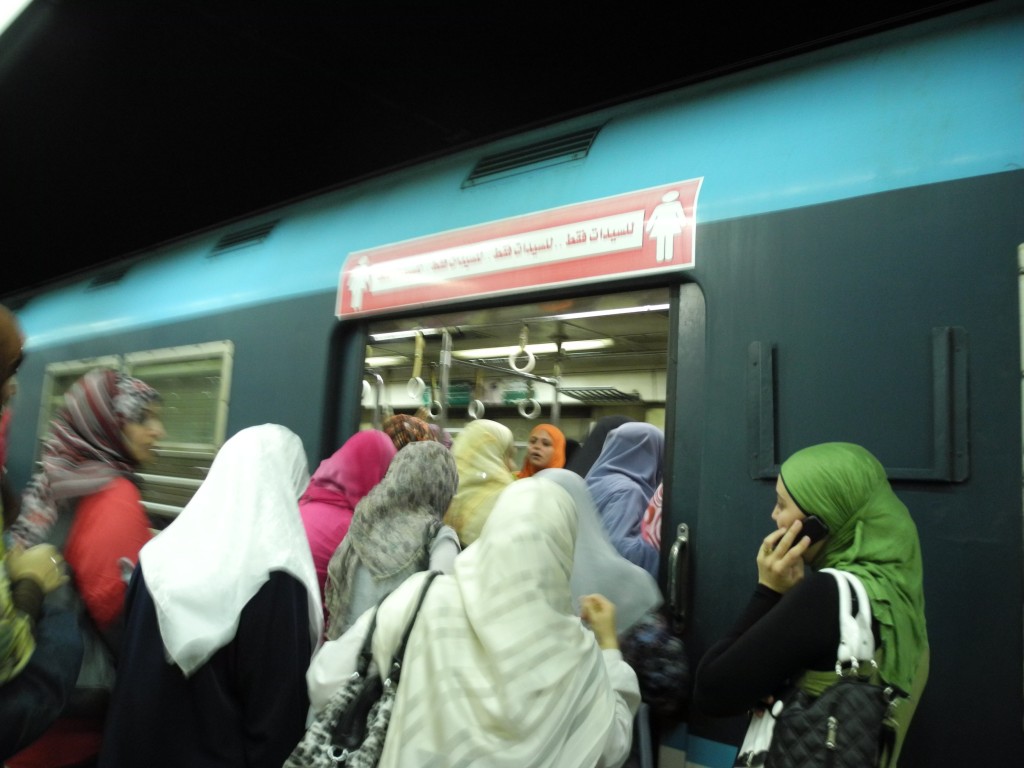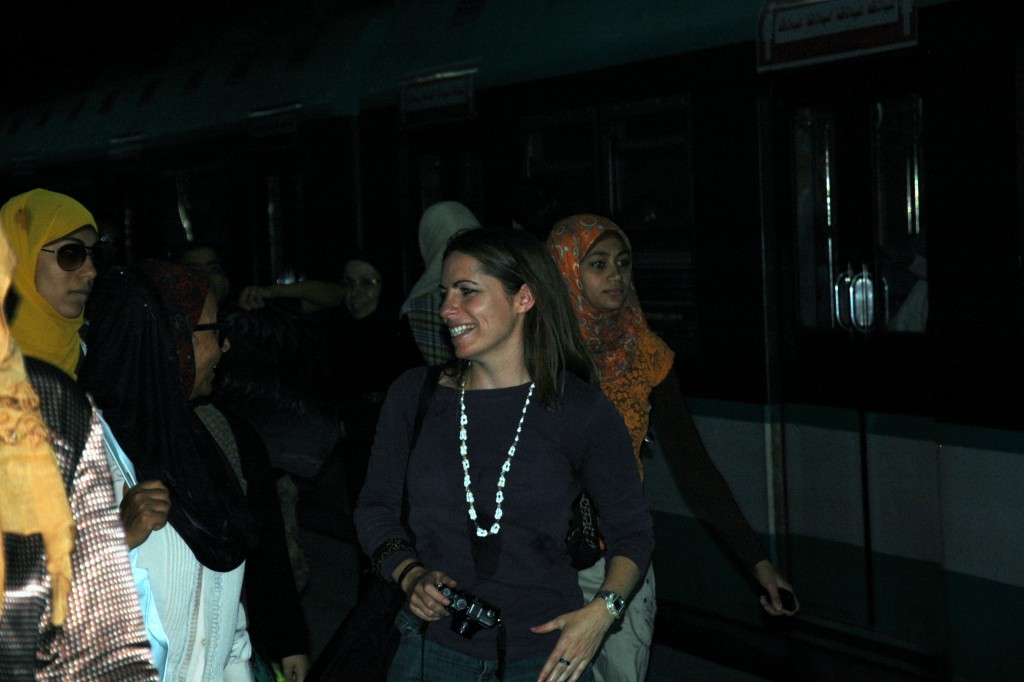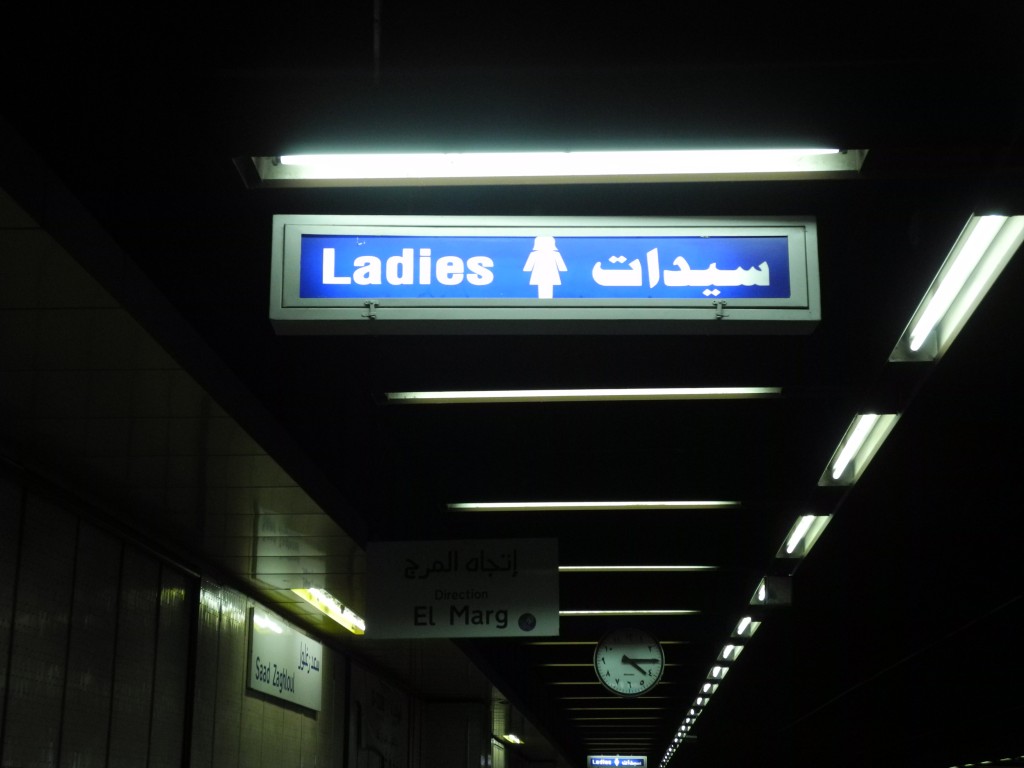
Recently I went to Egypt for a vacation with my dad. It was a great trip full of history, culture, and meetings with anti-street harassment activists. When we had two hours free on our last afternoon, I suggested we take a subway ride.
I’ve spoken, read, and written about women-only public transportation for years, but I’d never actually seen one before. I wanted to. I knew Cairo had women-only subway cars.
On a crowded subway platform in downtown Cairo on a Wednesday afternoon, groups of Egyptian women clustered together under brightly lit blue signs that read, “Ladies,” while men and a few women spread out across the rest of the platform. Once a subway train arrived, everyone rushed to board. Most women piled into the “Ladies Only” cars, designated by red signs above the doors. I joined them.
A few women assisted me when my bag got stuck in the closing doors. While it is not unusual to see women without head coverings on the streets, on the subway, as I looked around, every woman was wearing a hijab. Sweat poured from our faces because the car had no air conditioning on a 110 degree day. No one talked, but one woman, who was getting off at the next stop, gestured to offer me her seat. I thanked her, but I didn’t take the seat as I got off at the next stop too.

Leaving the train, masses of bodies churned past each other. One woman sought me out and spoke to me in English, asking where I was from and wished me a nice stay.
Next, I rode in a regular car where I was one of only three women among a mass of men. The two other women were accompanied by men who protectively wrapped their arms around them. I felt much less comfortable there than I did in the ladies-only car, in part because I was so out of place. While most men left me alone, one man standing next to me stared at me the entire two minutes. I avoided making eye contact with him and was relieved to leave the train at the next stop.
Most people in the United States are shocked when I tell them that other countries have resorted to women-only public transportation because sexual harassment is so bad. From the research I did for my book about street harassment, I know that countries ranging from Japan and Mexico to India and Egypt have subway cars and/or buses reserved just for women in their major cities.
While I’ve heard women say they are glad when they can ride in the women-only cars and take a break from being on guard and wary of male passengers, I don’t believe it should be the solution. The solution should be an end to harassment!
First, logistically, segregation does not solve the problem of harassment. Often the women-only transportation is only offered during rush hour and on major lines, throughout the day and city, most women must use the regular trains and buses. Platforms and bus lines are not fully sex segregated, nor are the streets people walk to reach the buses or subways, so there are plenty of opportunities to endure harassment. Sometimes men just get on the women-only cars anyway. (An Egyptian woman on Twitter just told me that a group of feminists in Egypt take videos of men who ride in the ladies-only car and post them on this YouTube Channel.)

Second, from a gender equality standpoint, it’s a frustrating that governments think the solution is gender segregation. Don’t we want integration and equality? Would segregation ever be considered a solution for race-based harassment? Why is it when it comes to men sexually harassing women? (If we do have to have sex segregation, should it be to segregate the harassers into their own subway cars and buses? Once you harass, you get stamped so everyone knows where you belong?!)
Instead, I think the governments and community groups should focus more effort on teaching respect in the schools, holding awareness campaigns, encouraging people to report harassers, and enforcing punishments for the worst perpetrators.
In Washington, DC, I am proud that I recently helped pressure the transit authority to do something about sexual harassment on our Metro train and bus system. At the suggestion of myself and others organized by Collective Action for Safe Spaces, the transit authority launched an anti-harassment public service announcement campaign, improved their employee trainings, and created an email address and online report form for incidents of harassment. These tactics do not place the onus on women alone to stay safe (e.g. some men say if women aren’t in the women-only cars, they’re “fair game” for harassment) and they provide people with constructive ways to deal with harassment.
What are your thoughts about women-only public transportation?

Emma Sundkvist says
Thanks for an interesting post but it made me curious how it comes you have been writing about segregated public transportation for years without even been on one. It seems a bit strange fir me. Ialso have a comment on your experience from Cairo’s metro. First, I’m not sure that the reason for having ladies only cars are because, as you argue, that girls and women can have a rest from harassements butfor the reason that some women have chosen to live a life more segragated from men that you, from US, and I, from Sweden, are used to. This can imply to train in a gym only for women, go in the “ladies only” car etc. In the women’s car, you can also see women breast feeding which is another reason to chose that way of transport. I believe you that you simple has missunderstood the reason to why the choice exists. Secondly, the experience you had in the mixed train is extremely different from my own. I have been living in Cairo for over 2 years and even though I prefer the women’s car, I have never experienced an uncomfortable ride in the mixed cars.